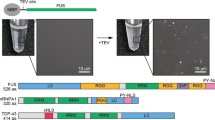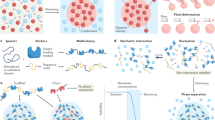Abstract
Phase transitions in cells provide a wonderful arena for investigation by students of physics, chemistry, and biology to come together to apply their foundational knowledge. In this article, we provide an intuitive approach to the basic physical principles of phase separation. We then highlight several examples that illustrate how the cell, the fundamental unit of life, makes use of phase separation to organise its contents.
Similar content being viewed by others
Suggested Reading
A Molliex et al., Phase separation by low complexity domains promotes stress granule assembly and drives pathological fibrillization, Cell, Vol.163, pp.123–133, 2015.
Svenja Lohner, Separate Liquids with Salt!, Scientific American, https://www.scientificamerican.com/article/separate-liquids-with-salt/.
P Li et al., Phase transitions in the assembly of multivalent signalling proteins, Nature, Vol.483, pp.336–340, 2012.
P Cramer, Organization and regulation of gene transcription, Nature, Vol.573, pp.45–54, 2019.
C P Brangwynne, T J Mitchison and A A Hyman, Active liquid-like behavior of nucleoli determines their size and shape in Xenopus laevis oocytes, PNAS, 108(11), pp.4334–4339, 2011. https://doi.org/10.1073/pnas.101715010.
M Feric et al., Coexisting liquid phases underlie nucleolar subcompartments, Cell, Vol.165, pp.1686–1697, 2016.
J Risso-Ballester et al., A condensate-hardening drug blocks RSV replication in vivo, Nature, Vol.595, pp.596–599, 2021.
S Wang et al., Targeting liquid—liquid phase separation of SARS-CoV-2 nucleocapsid protein promotes innate antiviral immunity by elevating MAVS activity, Nat. Cell. Biol., Vol.23, pp.718–732, 2021.
A Patel et al., A liquid-to-solid phase transition of the ALS protein FUS accelerated by disease mutation, Cell, Vol.162, pp.1066–1077, 2015.
Author information
Authors and Affiliations
Corresponding authors
Additional information
Kripa Gowrishankar is an assistant professor of physics at Azim Premji University.
Her research work is interdisciplinary, and she uses tools from physics to understand biological processes. At APU she develops classroom demonstrations as well as projects that engage students as active learners and help build their intuition of physical phenomena.
Sravanti Uppaluri teaches biology at Azim Premji University. She studies developmental biology using Hydra and C.elegans and works with undergraduate students to answer cell, size, and tissue organisation questions. She is part of the author team of www.iThinkbiology.in.
Rights and permissions
About this article
Cite this article
Gowrishankar, K., Uppaluri, S. An Introduction to Phase Separation in Cell Biology. Reson 28, 229–245 (2023). https://doi.org/10.1007/s12045-023-1545-0
Published:
Issue Date:
DOI: https://doi.org/10.1007/s12045-023-1545-0




